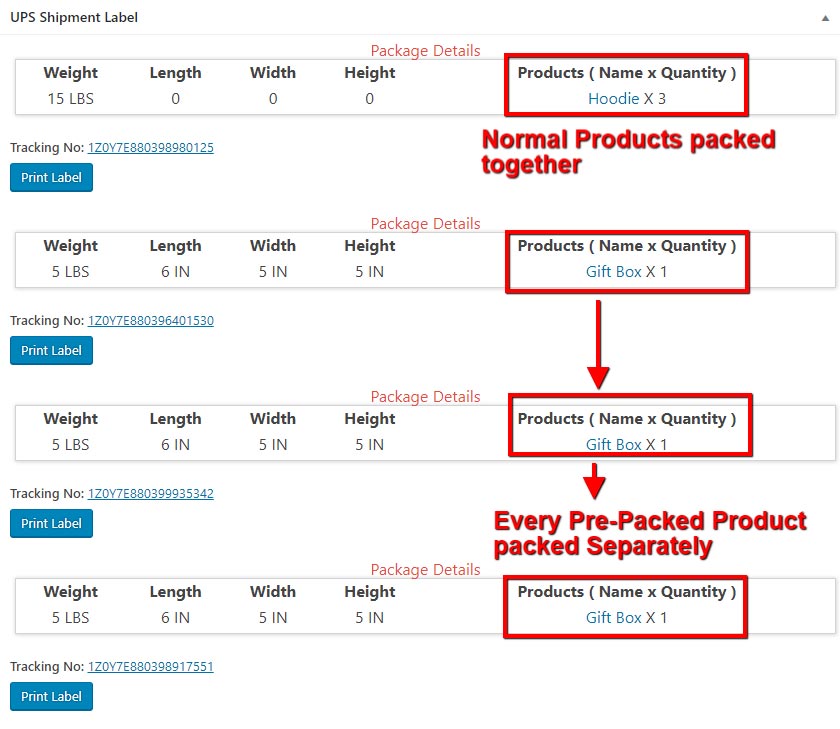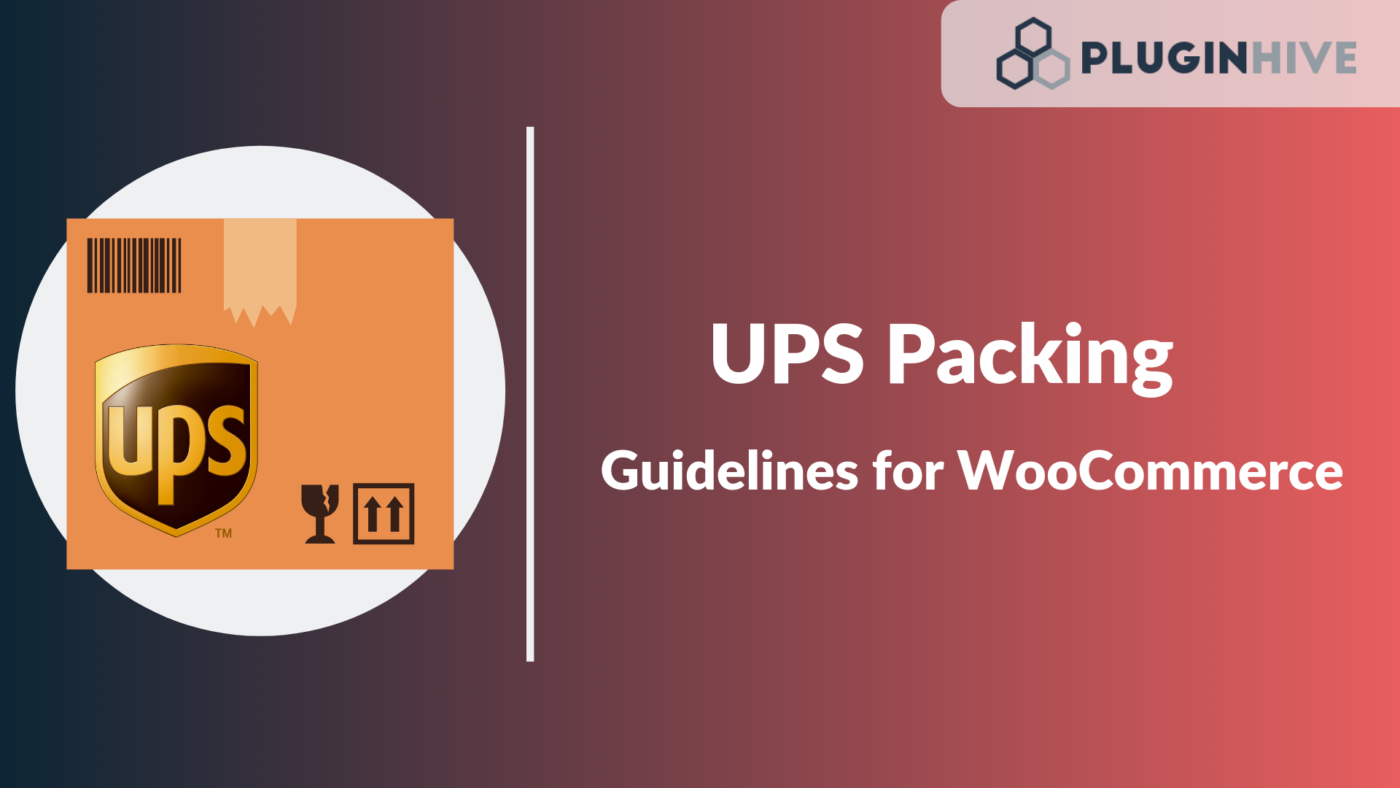This article will cover the available UPS Packing methods, the guidelines on how to pack a parcel and have it ready for shipping. It also takes you through a brief understanding of the various UPS packing methods available in the WooCommerce UPS shipping plugin.
Understanding the calculation of the weight and size of a package is important in order to obtain the correct shipping rates in your WooCommerce store.
How to Determine the Weight and Size of a Package
There is a simple formula set in place to measure packages for Ground services. This would be:
Length + 2x Height + 2x Width
- Step 1: Determining the Length of a Package
- The length of the package will be the measurement of the longest side of the package, being rounded off to the nearest inch.
- Step 2: Determining the Girth of a Package (2x Width + 2x Height)
- Begin by measuring the width of the package, rounding the value off to the nearest inch. Now, multiply this number by 2.
- Next, measure the height of the package, and round that value off to the nearest inch and multiply this number by 2.
- The girth is adding the above measurements (2x Width and 2x Height) together
- Step 3: Now that the Length and the Girth of the package have been calculated, add those values together. This is the package measurement.
- Step 4: In order to obtain the packages actual weight, place it on a weighing scale and note the value displayed, that is the packages actual weight.
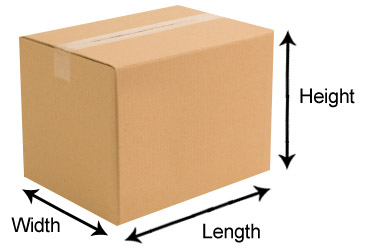
UPS Packing: Weight and Size limitations
There are various limits set by UPS for the weight and size of any given package. The restrictions listed below are only for individual packages. The advantage is that UPS does not have any limit to the total weight or the total number of packages in a UPS shipment. Any shipment that is larger than the limits listed below will require the use of UPS Freight services or UPS Worldwide Express Freight.
- Packages can be up to a maximum of 150 lbs
- The maximum of 165 inches (length+girth)
- Packages can be up to a maximum of 108 inches in length
- All packages with a large size-to-weight ratio will require special pricing and dimensional weight calculations
UPS Packing: Shipment Guidelines for Items with Irregular Shapes
Begin by measuring containers and boxes which are not the regular rectangle shape to see if a package is within the maximum limit prescribed. In order to obtain the measurement of an irregular package, you must begin to treat the package as if it was rectangular in shape and measure the height, length, and width from all the extreme points of the box.
There are a few examples listed below on packaging irregular shaped boxes, these are listed below:
UPS Packing for Strapped Boxes or Bundled boxes

- Packing
- Only boxes of the same size can be strapped together.
- A minimum of 4 crossed bands are required. 2 bands have to be facing in each direction.
- While strapping boxes together, make sure that each box is strong enough to hold the total weight of the strapped bundle. For example, if two boxes are strapped together and each weight is 40 lbs then both boxes must have a minimum weight capacity of 80 lbs.
- Labeling
- It is mandatory to have the address listed on every box.
UPS Packing for Wallpaper and Fabric
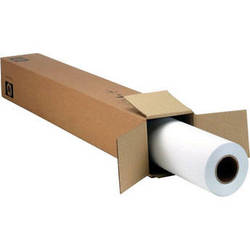
-
Packing
- It is advisable to pack all rolled goods in corrugated boxes to achieve the best results.
- A bag with a minimum thickness of 6 mills is required if the shipment is fabric or wallpaper rolled into a bag.
- The bag needs to be tightly wrapped and taped to reduce the risk of damage.
-
Labeling
- Securely tape the address label on the flattest surface of the package.
- The entire label needs to be covered with clear tape to minimize wear and tear.
- “Flying tags” (tags that hang from the item that you are shipping) are not permitted on such shipments.
- Duplicate address labels must be placed inside roll cores or between top layers of material.
UPS Packing for Tires

-
Packing
- A wide band of pressure sensitive tape is required to be placed completely around the body of the tire so the tape is attached to itself.
-
Labeling
- On the strip of tape covering the thread, attach your complete address.
- Now cover the label completely using clear tape.
UPS Packing for Other Irregularly Shaped Items

-
Packing
- Tape corrugated cardboard pieces to all sharp and protruding edges and corners of the item for protection.
- Cover the other surfaces of the item as needed.
-
Labeling
- Securely tape the address label on the flattest surface of the package.
- The entire label needs to be covered with clear tape to minimize wear and tear.
- “Flying tags” are not permitted on such shipments. (tags that hang from the item that you are shipping).
UPS Packing for Large Containers

-
Packing
- Use only those boxes whose strength has not been compromised by wear and tear or humidity.
- Each box has a Box Markers certificate located either underneath the box or on the bottom flap of the box. These weights which are specified are for palletized Freight shipments and not for the shipments being sent via small parcel carrier solutions.
- Make sure to remain within the prescribed size limit of the box and not to exceed it. Calculate the size limit by adding the length, width, and height of the box together. This is done because the weight limit specified on the Box Markers certificate would not be the same as the UPS combined length and girth measurement.
- This large box needs to be sealed with heavy-duty tape, preferably reinforced, by applying three strips to both the top and bottom of the box so that the middle and two edge seams are sealed.
-
Labeling
- Securely tape the address label on the box
UPS Packing: Parcel Shipment Guidelines for Standard Packages Over 70 lbs
It is important to evaluate your packaging materials to ensure that they are adequate for heavier package contents if the package weighs over 70 lbs (31.5 kgs). The following are the guidelines to pack parcels weighing over 70 lbs:
- The boxes used for large shipments have to have a strong construction, the seams should be stitched or stapled and not glued. All weight limits printed on the Box Maker’s Certificate are intended for palletized freight shipments, not for shipments through small parcel carriers.
- It is advisable to use new boxes that are at their full strength and that have not been compromised by humidity or the wear and tear of previous use.
- Use heavy-duty tape (preferably reinforced) while sealing a box, by applying three strips to both the top and bottom of the box, so that the middle seam and the two edge seams are sealed.
- Use only dense cushioning material to protect your heavy package contents. Expanded Polystyrene Peanuts and crumpled paper are not recommended as they won’t protect your shipment effectively because both materials crush and shift under heavy loads. A more effective solution will be to used customized corrugated board or engineered foam enclosures as they reinforce the rigidity of the outer box.
How to Determine the Actual Weight?
Actual weight is the package weight rounded up to the next whole pound.
Begin by determining the weight of a package by using a scale. All fractions are to be rounded off to the next for UPS Express® Envelopes (letters) over eight ounces and all other packages.
How to Determine the Dimensional Weight?
Dimensional weight is primarily the packages density. This is the amount of space a package occupies in relation to its actual weight.
All UPS domestic and international package service rates may be calculated using dimensional weights.
- Determine the package dimensions in inches.
- Measure the longest points, rounding each measurement to the next whole number. (for example, 1.00 to 1.49 will be considered 1, and 1.50 to 1.99 will be considered 2).
- Multiply the length of the package (longest side of the package) by the width and the height. The result produced will be the cubic size in inches.
- Now, divide the cubic size in inches by the divisor to calculate the dimensional weight in pounds and increase any fractional value to the next whole pound.
- The divisor varies by rate type: 139 for Daily Rates; 166 for Retail Rates.
Dimensional Weight = (L x W x H) ÷ Divisor L = Length in inches W = Width in inches H = Height in inches Divisor for Daily Rates = 139 Divisor for Retail Rates = 166
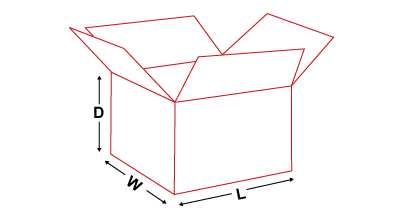
Density Weight
Density Weight is obtained by dividing the total handling unit weight by the total cubic feet. In order to obtain the total handling unit weight, you must: 1. First, measure the dimensions of the unit in inches. Note: When it is a palletized handling unit, the overall dimensions of the Freight including pallet will be used to determine the length and width. 2. Now, multiply the dimensions (L x W x H) to determine the total cubic inches of the handling unit 3. Finally, divide the total cubic inches by 1728 to convert to total cubic feet *Note – You can use the following Density Weight calculator provided by UPS: Density Weight CalculatorHow to Determine the Billable Weight?
Compare the package’s actual weight to its dimensional weight. Calculate the billable weight by picking the weight greater amongst the two (actual weight and dimensional weight) this should be used to calculate the rate. For multiple-package shipments, total the billable weight of all packages in the shipment.
UPS Packing: Pallet Shipment Sizes and Packing Guidelines for UPS Freight
For all WooCommerce UPS shipments made using UPS Worldwide Freight and Air Freight services, have a few guidelines and procedures one must follow so as to ensure the pallet arrives at the destination intact and on time. These are:- Begin by choosing a sturdy and firm pallet, one that is strong enough to support the load of the shipment.
- A good quality pallet is made up of either wood or plastic and weighs normally between 20 – 70 lbs.
- The boxes and cartons chosen will have to be of good quality and has the strength to contain what is being shipped. These cartons will have to be stacked vertically in columns on the pallet.
- It is mandatory to use the stretch wrap (minimum of 60 gauge quality) while securing boxes or cartons to the pallet.
- All shipments to and from the United States have to be secured to the pallet either with metal strapping or with unbreakable plastic straps. This has to be done on individual packages being shipped that weigh over 150 lbs.
- Make sure that each pallet is labeled with telephone numbers and complete address information, including the postal codes for the shipper and the consignee
Determine the Billable Weight of Your Pallet
How to Determine billable weight?
Begin by determining the actual weight of the package. The actual weight of a package is the weight of the items on the pallet and the weight of the pallet rounded up to the next whole pound.-
It is recommended to use a scale to determine the weight. All fraction values have to be rounded up to the next whole pound.
How to Determine the dimensional weight?
Dimensional weight of a package is the amount of space a pallet occupies in relation to its actual weight. Dimensional weights may apply to all shipments sent via UPS Worldwide Express Freight.- Begin by determining the pallet dimensions in inches. For each dimension, measure the longest points. Each measurement should be rounded off to the next whole number (e.g. 1.00 to 1.99 will be considered 1 to 2.00 and 0.5 to 1.49 will be considered 0.5 to 1.50).
- Now, multiply the pallet length by the width and the height. The result you receive is the cubic size in inches.
- For all export and import shipments, to determine the dimensional weight divide the cubic size by 139 when measured in inches. Increase any fraction to the next whole pound (e.g. 1.50 will be 2.00).
Various UPS Packing Methods used in the WooCommerce UPS Shipping plugin
This section of the article covers an all-round shipping solution that abides by the guidelines set for UPS Packing. We’ll be covering the topic on the Parcel packing methods available within the WooCommerce UPS Shipping plugin and explain the differences between the UPS packing methods.First, set up the plugin by referring to the following document
In order to pick the most appropriate packaging method, you must navigate to WooCommerce > Settings > Shipping > UPS > Parcel Packing (shown below)
 The 3 parcel packaging methods are:
The 3 parcel packaging methods are:
- Default: Pack items Individually
- Recommended: Pack into boxes with weights and dimensions
- Weight-Based Calculate shipping on the basis of the orders total weight
Default: Pack items individually
- In this option, each item in the cart is packed separately. Calculate the total cost of shipping by adding the shipping cost for each item. Hence labels are also generated separately.
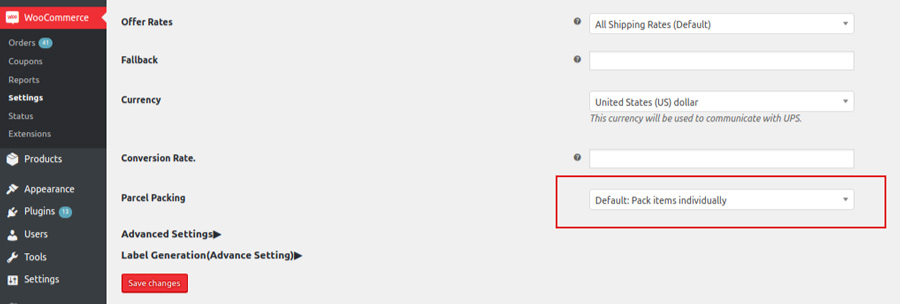
Recommended: Pack into boxes with weights and dimensions
- If packing items individually do not suit your business, you can define required box sizes under Box Dimensions section. All the cart items are packed into custom boxes defined in Box Dimensions settings. The best fit box is auto chosen from the defined boxes. You can read more about this packaging method by reading about it here
- While packing into Boxes, kindly look into the following points:
- UPS Packaging Select from the various UPS Standard Boxes (Letter, Tube, PAK, 10 & 25 KG Box, Small Medium & Large Express Box)
- Custom Box dimensions Specify the dimensions of custom boxes within the table by mentioning their Outer Dimensions and Inner Dimensions along with the box weight and maximum weight. This enables the plugin to select the most appropriate box for the shipment and rates are calculated based on the box chosen.
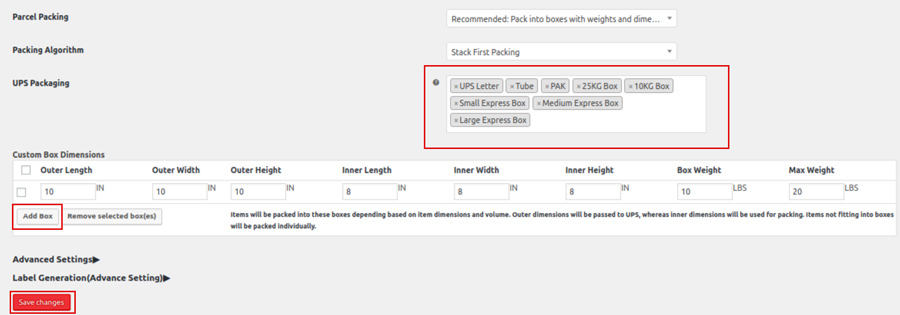
Weight-Based: Calculate shipping on the basis of orders total weight
- Here, the weights of all the items in the cart are added and passed on to UPS in order to get real-time rates. You have to just define a Max Weight which will determine the maximum weight that can be packed in a single package. All the products up to the Max Weight will be packed inside a single package and once the Max Weight is reached, the plugin will create a new package. You can read more about this method of packing here
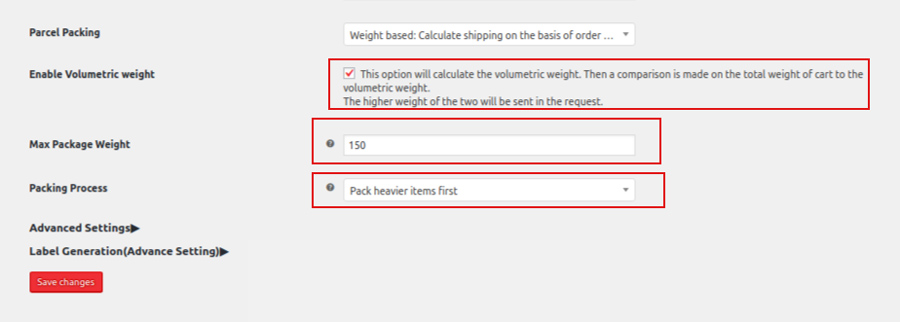 The additional fields which determine the rates are:
The additional fields which determine the rates are:
- Enable Volumetric Weight
- Here, This option will calculate the volumetric weight. Compare the total weight of cart to the volumetric weight. The request takes the heavier of the two weights.
- Max Package Weight
- Maximum weight specified for individual boxes.
- Packaging Process
- Choose the preferred packaging order. The values to choose from are
- Heavier items first
- Lighter items first
- Pack purely divided by weight
- Choose the preferred packaging order. The values to choose from are
Flexible Parcel Packing for your WooCommerce Shipments
- Till 70 lbs you want to pack all items in the cart into a single package.
Weight-Based Packing with Max Weight Set to 70 lbs
 Along with the Weight-based packing, Gabriel would require to enable another option in the product level which will create a separate package for the products.
Along with the Weight-based packing, Gabriel would require to enable another option in the product level which will create a separate package for the products.
Pre-Packed Product
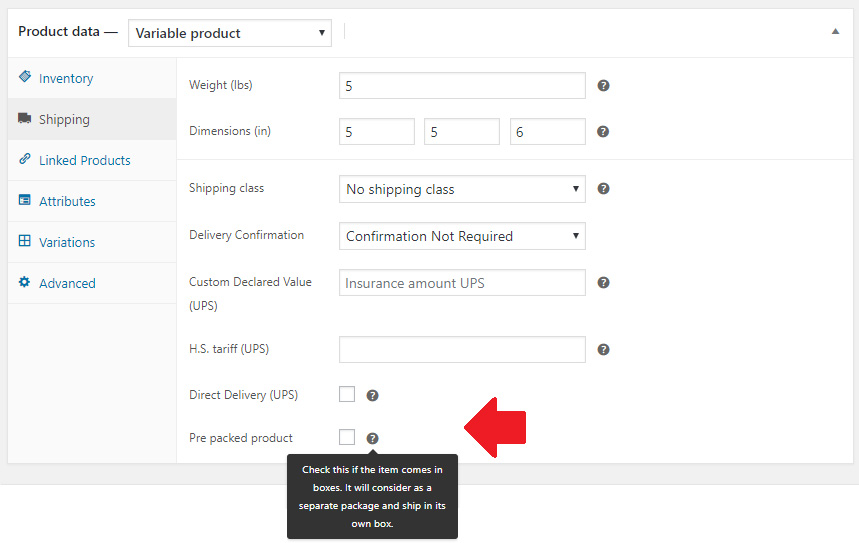 Hence, once you have enabled this option, every time a customer purchases this product it will be packed separately from the other products.
Now, let us check what happens when the Pre-Packed products are purchased and shipped together with a normal product which requires a weight based packing with 70 lbs max weight limit.
Hence, once you have enabled this option, every time a customer purchases this product it will be packed separately from the other products.
Now, let us check what happens when the Pre-Packed products are purchased and shipped together with a normal product which requires a weight based packing with 70 lbs max weight limit.
Scenario 1: Shipping Pre-Packed Product with a Normal Product
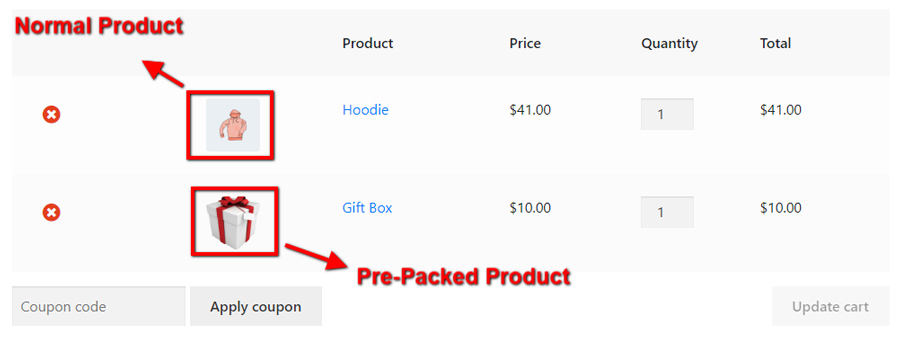 You can see in the above image, you can clearly see both the pre-packed as well as the normal product together in the cart. Once, the order is placed, and the packages and labels are created, you can easily check how the products are packed.
You can see in the above image, you can clearly see both the pre-packed as well as the normal product together in the cart. Once, the order is placed, and the packages and labels are created, you can easily check how the products are packed.
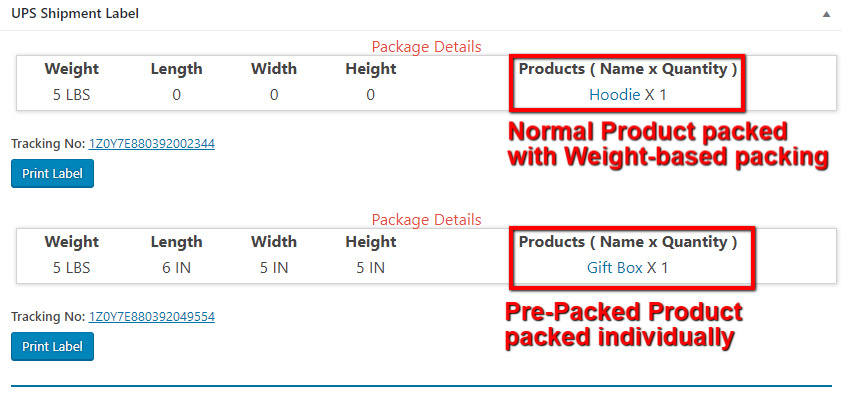
Scenario 2: Shipping Pre-Packed Product with Multiple Normal Products
 In the above image, you can clearly see both the pre-packed as well as multiple normal products together in the cart. Once, the order is placed, and the packages and labels are created, you can easily check how the products are packed.
In the above image, you can clearly see both the pre-packed as well as multiple normal products together in the cart. Once, the order is placed, and the packages and labels are created, you can easily check how the products are packed.
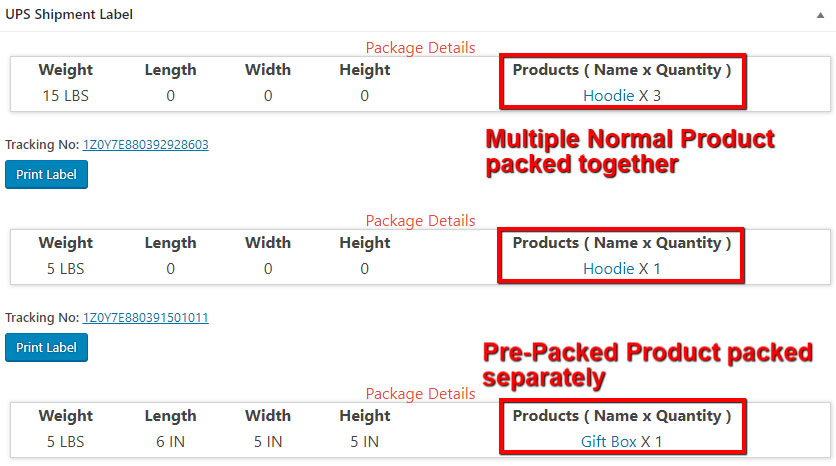
Scenario 3: Shipping Multiple Pre-Packed Products with Multiple Normal Product
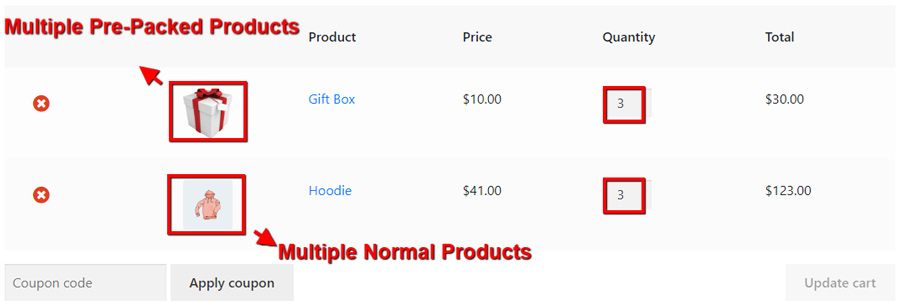 In the above image, you can clearly see multiple pre-packed as well as multiple normal products together in the cart. Once, the order is placed, and the packages and labels are created, you can easily check how the products are packed.
In the above image, you can clearly see multiple pre-packed as well as multiple normal products together in the cart. Once, the order is placed, and the packages and labels are created, you can easily check how the products are packed.
